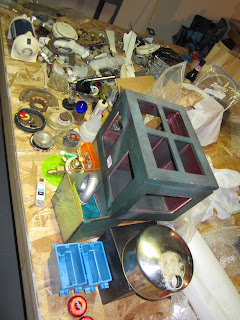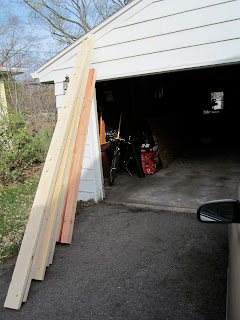Big Games, in D-Company fashion, are traditionally contests where players bring their biggest armies to the table for an Apocalypse-type fight, where players haul out their collections and put them on display for everyone else to see. Gargantuan creatures, Superheavy vehicles, Flyers, and units too expensive to be fielded in a normal game make their appearance. It is a time where players can show off their greatest conversions, the scope of their study of a codex, and play all day in a great contest of utter force.
I've participated in my fair share of Big Game events with the D-Company crowd. There was (some with the names I give them) the "Freezer Game," "Capture the Redeemer," "Assault Fort Louise," "Guns of Navarone," "Braden's Big Crunch," "Mungus Town," "Dan's Big Cathedral," "Bridge Game," and others. I've come up with a few things that I'd like to see in big games over time, and am brainstorming ideas for a new one, whether or not this is the "next one" or the "next one after the next one" or after that remains to be seen. Anyone concerned with this should bear in mind that this is just an
idea, and not a plan
per se, and rather a brainstorm because the subject has come up and is rolling around in my head while I am at work and is an entertaining thought to me, at best.
I'll begin with an idea of what I'd like to see in big games, or more correctly, what I'd like
not to see in big games.
WHEREAS,
1) I like to see armies mix. I don't like big games where players square off against another army for most of the battle. Sometimes in larger games this is inevitable, but I think the best moments in big games are where armies from different codexes support one another and become part of an overall battle.
2) I like to see big games last a good number of turns. No one feels like big games are complete after three turns, but at times big games can take hours for a single turn to complete.
3) I like to see units that aren't normally seen in smaller games. Big games should be punctuated with special units like Titans and Gargants, Special Characters and, lest anyone forget the initialism, VDR. A Big Game with armies of only 2,000 points aren't really big games, in my opinion.
4) A combined goal. A Big Game should reflect an overall battle, a common theme and flavor. Big games that lose the reason-for-the-fight get to be giant slog - fests, which are fine if you're looking for such a thing, but I, however, am not.
5) Ample real-estate. I like to see lots of land open for the taking in Big Games, games where a forward position means more than just "a little bit ahead of the gun lines behind you."
6) Inclusion. Armies should not be prevented from a Big Game just because they are of a "minor" codex, like Necrons or Eldar, nor should a player be prevented from coming and participating in a big game because they don't hold 5,000 points in an army, or can only come one day instead of two. It is too bad that some people have busy lives, but would still like to come and play a few games in the company of the D, but cannot realistically commit to two days in a hotel on a bender that will take a year off their already shortened lives.
THEREFORE, with these principles in mind, I came up with the following scenario that I submit for comment. Please feel free to comment on it here, or PM me on the D-Company website: http://www.d-company-wi.com/ . My username is Pen Dull, if you haven't guessed already.
BIG GAME 201X, v. 1.0
Pre Game: Each team chooses a General. The general will be a "leader" of the team, responsible for his team's organization, facilitating fair team division, deployment strategy,
et cetera, and answer to the game designer. Each general will be present for both days of the game. Each player will build a list (or lists) used on the first day from 500 - 2,000 points. They will also build another list for the second day that will be "as big as they want." The recommended size for this list will be from 5,000 to 10,000 points, but players should be able to handle their army correctly and efficiently and anything over 7,000 points should include really-big-stuff (like Apocalypse units).
Day One: Players show up and play up to three games on any of the eight tables shown in the diagram below. The first six tables will be for armies over 500 points, the last two "Skirmish Tables" will be for 500 point armies playing a "Patrol" mission.
Why play these games? Simply because during day one players are sometimes local, and sometimes not. Players can "jump in" to the action immediately, start scoring points for their team. FOR EACH GAME WON on one of the six tables the players will win a victory "chit." These "chits" will be spent at the end of the night, to increase the deployment possibilities for his team.
Players will arrive at the hall, set up tables, and then claim one of the eight tables and wait for an opponent. The next able opponent that arrives (from the other team, of course) will be paired with an available opponent, and they will play a "normal" game of 40k on that table, deciding the victory conditions amongst themselves and playing at their own pace. The winner of the game will report to his general that he has won a game, and how many "Territory Chits" he has scored for his side. The loser of the game will be given a "Road Construction" token, and be mocked for being sent onto the road crew for a month (more on this later).
4x6 Tables vs. Skirmish Tables: The 4x4 Skirmish tables are for 500 point armies (or less) only. Players may match wits in a short skirmish of scouting forces, trying to secure the more tactical positions on the battlefield. Chits won from the Skirmish Tables will be kept separate from the other chits, will be called "Skirmish Chits," and be used in a different fashion, described below.
Territory Bidding
At the end of day one, players will break down the 4x6 tables and use the terrain to populate the "big table." Generals will meet with the game designer who will act as a mediator during the territory bidding process. Each general will roll a die. The winner will place a
Skirmish Chit on either the Urban Wasteland or the Airport territory. Then his opponent will do the same. Each General will place a Skirmish Chit, one at a time, until they are all placed on either the Urban Wasteland or the Airport territory. The greatest number of Skirmish Chits "wins" that territory, at least for now. It is possible that a team may win
both the Airport and the Urban Wasteland.
Next, the Generals will collect their
Territory Chits. Each will roll a die, and the winner will place a Territory Chit on a Territory that is
adjacent to the team's General Deployment Area or a territory won by Skirmish Chits (Airport or Urban Wasteland). Each general will then place a chit, one at a time, on any territory that already has one of his chits in it, or in a territory that is adjacent to a territory that contains one of his own chits. This continues until the generals have no more chits to place.
Special Chit Placement: A general may, at his discretion, instead of placing a Territory Chit, discard TWO of his Territory Chits to remove any one single chit from the board. A general may also, instead of placing a Territory Chit, discard any number of chits to add a bonus number equal to the number of chits discarded to the "First Turn Roll Off." Either way, chit placement then moves onto his opposing general.
At the end of this procedure (which seems like it would take a long time but it won't really), teams with the most chits on a territory will win that territory as a
deployment zone.
Why do this whole chit thing? The game is won by the team owning the most number of territories, and securing a forward position. If players are skilled and daring, they may be able to deploy their forces onto a territory and stop the enemy's advance early on. Furthermore, we might find armies almost completely surrounded and fighting off multiple enemies at one time, in a truly heroic fashion but sometimes strategical genius.
End of Day One: Players deploy their forces. Players may place buildings they are paying for in points in the deployment zones they have won, and their forces entirely within a single zone. Infiltrators and Scout moves are resolved, and if time is willing, opponents roll for first turn, adding bonuses for Chits discarded during the bidding phase, and an unmodified Seize the Initiative roll. Players will refer to a table edge as the edge that their territory touches the table.
Players who DID NOT participate in the day one Skirmishes or 4x6 tables will only be able to deploy in the General Deployment area.
ROAD CREW: What happened to the players that were on the road construction? Players who lost a game can still help, buy using their Road Construction points to build roads. Those will be pooled by the team, and players may trade in each to construct 12" of road. This way, the "losers" of the pre-games will have faster access to contest objectives. Roads can demolish non-player-purchased terrain, plowing straight through. Players can create lines of fire, or create pathways for conga-lines of land-raiders to advance. Bonus movement will be given for these roads. Road building will occur before infiltrators and scout moves.
Next day, the game begins, and players duke it out. Winning side has the most number of territories under his control, plus other cool mini objectives that will be scattered about the map (most likely using the variable objective rules in the new rulebook).






































































